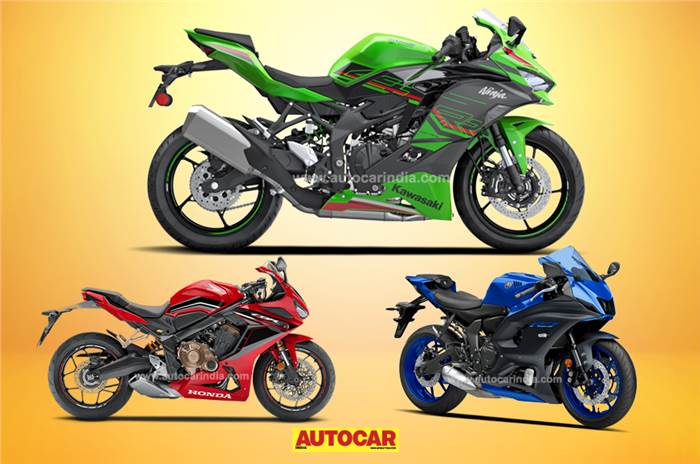It’s hard to argue against the fact that the Kawasaki Ninja ZX-4RR is one of the most incredible new bikes in recent times. You’ll have to go back to the 1990s to find the last 400cc inline-four. What makes the 4RR special is not just the fact that it exists, but that it’s not some USA or Japan special; it’s going to be available in most major markets, courtesy of being Euro 5-compliant.
Kawasaki Ninja ZX-4RR vs rivals: engine
| Engine | |||
|---|---|---|---|
| Kawasaki ZX-4RR | Honda CBR650R | Yamaha YZF-R7 | |
| Engine | Liquid-cooled, 399cc, inline-four cylinder | Liquid-cooled, 649cc, inline-four cylinder | Liquid-cooled, 689cc, parallel-twin |
| Power | 77hp (80hp with Ram air) | 87hp at 12000rpm | 73.4hp at 8750rpm |
| Torque | 36Nm at 11,000rpm | 57.5Nm at 8500rpm | 67Nm at 6500rpm |
| Gearbox | 6-speed | 6-speed | 6-speed |
The headline figure for the Kawasaki has to be its 80hp power output. That makes it more powerful than the much larger Yamaha R7, and very nearly as powerful as the India-spec Honda CBR650R, which also has an inline-four. Looking beyond the headline figures, though, it’s obvious that the Ninja is going to deliver its power very differently to the other two bikes here.
The most real world-usable of these engines is likely to be the Yamaha, because it delivers its peak figures far earlier in the rev range than the others, and it’s comfortably the torquiest motor here. You’ll have to work harder to extract the most out of the CBR’s engine, but you’ll have to dig even deeper to unleash the maximum from the Ninja, and this is going to be the peakiest motor here. With just 36Nm on tap, it’s also got the least torque, by quite a margin, so it produces its heady power figure by virtue of astronomical revs (Kawasaki hasn’t even revealed what RPM the peak power comes in at), and we know it exceeds 15,000rpm.
Kawasaki Ninja ZX-4RR vs rivals: chassis
| Chassis | |||
|---|---|---|---|
| Kawasaki ZX-4RR | Honda CBR650R | Yamaha YZF-R7 | |
| Chassis | Trellis frame | Perimeter frame | Diamond-type frame |
| Suspension (f/r) | 37mm USD fork / Monoshock | 41mm USD fork / Monoshock | 41mm USD fork / Monoshock |
| Tyres (f/r) | 120/70-ZR17 / 160/60-ZR17 | 120/70-ZR17 / 180/55-ZR17 | 120/70-ZR17 / 180/55-ZR17 |
| Brakes (f/r) | 290mm discs / 220mm disc | 310mm discs / 240mm disc | 298mm discs / 245mm disc |
There are varying degrees of seriousness on the chassis front, and unsurprisingly, the Ninja comes across as the most serious of the bunch in many ways. Suspension is fairly high-spec, with a Showa SFF-BP upside-down fork that’s adjustable for preload, and a fully adjustable BFRC monoshock that features the same technology seen on Kawasaki’s flagship superbike, the Ninja ZX-10R.
The other two here also get a Showa SFF-BP upside-down fork (a fatter 41mm unit compared to the Kawi’s 37mm), but the Honda’s is non-adjustable, and the Yamaha’s is fully adjustable. At the rear, both the Honda and the Yamaha get only preload adjustability. As the heaviest bike here, the Honda comes with the largest front brake discs, and as effectively the lightest bike here, the Ninja gets a slimmer rear tyre than the other two.
Kawasaki Ninja ZX-4RR vs rivals: dimensions and weights
| Dimensions and weights | |||
|---|---|---|---|
| Kawasaki ZX-4RR | Honda CBR650R | Yamaha YZF-R7 | |
| Kerb weight | 188kg | 211kg | 211kg |
| Ground clearance | 135mm | 132mm | 135mm |
| Seat height | 800mm | 810mm | 835mm |
| Fuel capacity | 15 litres | 15.4 litres | 13 litres |
| Wheelbase | 1380mm | 1449mm | 1395mm |
On paper, the Ninja and the Yammie weigh exactly the same, but the Kawi manages to do this while carrying 15 litres of fuel, while the R7 only holds 13 litres, so the ZX-4RR is effectively the lightest bike here. It’s not quite as light as its displacement might suggest, though, and having a four-cylinder engine has certainly bumped up its weight – it’s a whole 20kg heavier than the Ninja 400, which displaces the same, but has only two cylinders.
The focused nature of these machines is evident in the fact that the maximum ground clearance here is a meagre 135mm from the Kawasaki and the Yamaha, with the Honda even lower, at 132mm. For all its hardcore nature, the Ninja actually gets the lowest seat height here, at a reasonably accessible 800mm, while the Yamaha’s perch is at a slightly high 835mm. Unsurprisingly, the 4RR has the shortest wheelbase here, while the CBR is the most stretched out of the lot, clearly marking itself out as a sport tourer rather than an out-and-out sportbike. At 211kg, the Honda is also clearly the heaviest bike here, and as a result of this, despite being more powerful than the Ninja, it has a lower power-to-weight ratio.




Comments
Member Login
Personal Details
No comments yet. Be the first to comment.